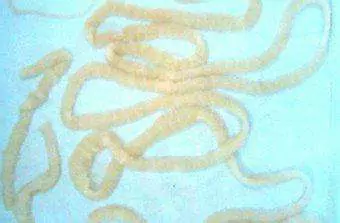How do dogs get tapeworms? Tapeworms, the most common parasite in dogs
2022-07-01
How do dogs get tapeworms
Tapeworm disease in dogs is also a common parasitic disease, which is dangerous because the tapeworm larvae can infect humans and various domestic animals, endangering lives and causing economic losses. There are many kinds of cestodes in dogs, and their life history is that the mature pregnant egg segments of the cestode are excreted in the feces and fed on by intermediate hosts (different species of cestodes have different groups of intermediate hosts, such as the canine multiheaded cestode, whose intermediate hosts are cattle, sheep, horses, camels and humans, forming multiheaded larvae in the brain and spinal cord, endangering the lives of humans and animals). Cestodes are formed in various organs of each intermediate host; eventually, dogs eat various animal carcasses and offal containing cestodes, which develop and mature into various cestodes in the small intestine.
銆€銆€Symptoms: Tapeworm infections in dogs are usually not obvious, except for milky white tapeworm nodules seen in the dog's feces. Abdominal discomfort, anemia, lethargy, and indigestion can occur in large numbers of infections.
銆€銆€Prevention and treatment: Raw pumpkin seeds are very effective in worming. The key is to understand the hazards and pay attention to personal and environmental cleanliness and hygiene.

Tapeworms, the most common parasite in dogs
The parasites in dogs include internal and external parasites. Generally, internal parasites include tapeworms, roundworms, coccidia, trichomonads, hookworms, toxoplasma, etc., while external parasites include ear mites, ticks, fleas, lice, mange mites, etc. Whether internal or external parasites, if the dog is infected, it will cause certain effects on the dog's health, therefore, it is advisable for the owner to deworm the dog regularly.
Tapeworms belong to the invertebrates of the flatworm family Cestoda, often parasitic in the bodies of humans and some animals such as domestic animals, cats, fish, causing a zoonotic disease called tapeworm disease, collectively known as tapeworm disease, generally appear after people eat meat products containing cysts tail pieces, mainly manifested as digestive tract disorders, the high incidence of areas such as northeast, northwest, north China, Yunnan, Guizhou and other regions. However, today we are mainly discussing the tapeworm in dogs, other animals will be left out for now. There are many species of tapeworms that live in the small intestine of dogs, and not only is the adult stage very harmful to the health of dogs, but most of their larval stages use other livestock (or humans) as intermediate hosts, seriously endangering the health of livestock and humans.
Classification of tapeworms
1. Canine tapeworm (also known as canine compound tapeworm and melon tapeworm): The body of the canine tapeworm is light red and can even reach 10 to 15 cm in length, with mature body segments 7 mm long and 2 to 3 mm wide, with an elongated ovoid shape and an appearance like cucumber seeds. Each mature segment contains two sets of male and female reproductive organs, and the reproductive pores are open at the center of both sides of the segment. Fleas and canine lice are the intermediate hosts of canine tapeworms, which develop as cysticercus-like larvae in their bodies. The final host is infected by ingesting the flea or louse containing the cysticercus, and develops into an adult in the small intestine in about 3 weeks.
2, fine-grained echinococcosis tapeworm: the body consists of a head segment and three to four segments, with a total length of no more than 7 mm. There is a set of reproductive organs in the mature segment, and the length of the pregnant segment is more than half of the full length of the worm, and the uterus is sac-shaped, without lateral branches, only some protrusions. The larvae of the fine-grained echinococcosis tapeworm are echinococcosis larvae, which are parasitic in the liver, lungs, and other organs of many animals and humans, and dogs are infected by eating organs containing echinococcosis larvae.
3. The multiheaded tapeworm (also called multiheaded tapeworm) has a raw body length of 40 to 100 cm and a widest point of 5 mm, with 9 to 26 pairs of lateral branches in the uterus. The intermediate hosts are cattle and sheep, and the larvae are polycephalic larvae (cerebral co-occurring larvae), which are parasitized in the brain of the intermediate hosts and sometimes in the cerebrum or spinal cord. Dogs are infected by swallowing brains containing polycephalic pigs, which develop into adults after about 41 to 73 days.
4, bean-shaped tapeworm (also called serrated tapeworm), the worm is 60 to 200 cm long, the reproductive pores open irregularly on one side of the segment, slightly protruding, so that the lateral edge of the worm is serrated, the length and width of the mature body segment is 10 to 15 mm X 4 to 7 mm: the uterus has 8 to 14 pairs of lateral branches. The intermediate hosts are rabbits and hares, and the larvae are bean-like cysticerci that parasitize the liver, omentum, and mesentery of rabbits. The larvae are bean-shaped cysticercus and are found in the liver, omentum and mesentery of rabbits.
5. Vesicular tapeworm (also called marginal tapeworm): The body is 75 to 500 cm long, with wide and short anterior segments and gradually lengthening posterior segments, and the mature body segments are 10 to 14 mm long and wide X 4 to 5 mm. The uterus has 5 to 10 pairs of large lateral branches which are then divided into smaller branches, each segment has a set of reproductive organs, and the reproductive pores open irregularly on one side of the segment. The intermediate hosts are cattle, sheep, pigs and other domestic animals, and the larvae are fine cysticercus larvae, which are parasitized in the liver, omentum and mesentery of the intermediate hosts, etc. Dogs are infected by swallowing the viscera containing fine cysticercus larvae and develop into adults in the small intestine after 36 to 73 days.
6. Cestode (also called midline tapeworm): The body is 30 to 250 cm long and 3 mm wide at its widest point. Each segment has a set of reproductive organs, and the uterus is located in the center of the segment and is longitudinally long capsule-shaped, so the eye sees a longitudinal line running through the central part of the chain body of this species of tapeworm. The first intermediate host is a dung-feeding mite, which forms cysticercus-like larvae in its body. The second intermediate host is snakes, frogs, birds, and rodents, in which the tetrahymena are formed, mostly in the abdominal cavity or liver and lungs of the second intermediate host. After being ingested by the final host, the larvae become adult worms after 16 to 20 days.
7. Mannheimia cestode (Doula cestode): The body is about 100 cm long and 2 to 2.5 cm wide. The head segment is finger-shaped, and there is a longitudinal suction groove on each side of the dorsal and ventral parts. The cervical segments are elongated. The segments are generally wider than long. The pregnant egg segments are almost equal in length and width. There is a set of reproductive organs in the mature segment, with a round male reproductive pore in the anterior center of the segment, a spirally coiled uterus located in the middle of the segment, and the terminal opening of the uterus and the vaginal opening located below the male reproductive pore. The body is yellowish gray, with a grayish-black dotted line in the center of the segment due to the uterus and eggs. C. mansoni requires two intermediate hosts: the first intermediate host is a freshwater copepod (e.g., Daphnia magna), in which the protozoa develop. The second intermediate host is frogs and snakes (fish, birds and even dogs can be used as transit hosts), in which the larvae develop. Cats and dogs are the final hosts in which the larvae develop into adult worms in the small intestine.
The diagnosis of tapeworms is usually unnoticeable in mild infections except for occasional discharge of mature nodules. In severe infections, there are appetite disorders (gluttony, heterophagia), vomiting, chronic enteritis, alternating diarrhea and constipation, anemia, emaciation, agitation or depression, and in some cases, spasms or limb paralysis. When the worms form a mass, the tapeworm can block the intestinal canal, leading to acute abdominal conditions such as intestinal obstruction, intussusception, intestinal torsion and intestinal rupture.
Therapeutic deworming of tapeworms: Use hydrobromine betaine at a dosage of 1.5 to 2 mg/kg body weight, administered orally. Make the sick dog fast for 12 to 20 hours and then administer the drug. To prevent vomiting, dilute iodine tincture solution (10 ml of water and two drops of tincture of iodine) should be given 15 to 20 minutes before administration of the drug. Or use praziquantel at a dosage of 5 to 10 mg/kg body weight, once, orally. Or use butanedimidine hydrochloride at a dosage of 25 to 50 mg/kg body weight, 1 time, orally, to expel fine-grained echinococcosis tapeworm with 50 mg, followed by 1 time at an interval of 48 hours.
Prophylactic deworming is definitely better than treating the disease once it is acquired. Prophylactic deworming should be carried out four times a year (once a quarter) for tapeworm prevention, and within 3 to 4 weeks before breeding. The dog should be isolated within a certain area during deworming so that the excreted worms and feces can be collected and thoroughly destroyed to prevent the spread of pathogens.
Of course, everything requires the dog owner to give them attention to cleanliness and hygiene to eliminate the source of infection. Properly dispose of slaughter waste and prevent dogs from feeding on intermediate hosts with tapeworm larvae or their uncooked organs. Keep the kennel and the dog clean, use insecticides frequently to kill fleas and lice on the dog's body, and eliminate rodents. All kinds of infectious sources that need to be careful should be paid attention to in order to ensure the health of the dog as much as possible.
#
Intermediate host
#cysticercus cellulosae
#worm body
#parasite
#uterus
#genital pore
#insect repellent
#somite
#reproductive organ
Was this article helpful to you?
Other links in this article
Français:
Comment les chiens attrapent-ils le ténia ? Le ténia, le parasite le plus fréquent chez le chien.
português (Brasil):
Como os cães recebem as ténias? As ténias, o parasita mais comum nos cães
русский:
Как собаки заражаются ленточными червями? Ленточные черви, самый распространенный паразит у собак
中文简体:
狗是怎样得到绦虫的?狗狗体内最常见的寄生虫之绦虫
中文繁体:
狗是怎樣得到絳蟲的?狗狗體內最常見的寄生蟲之絳蟲
Comments

Why is my dog throwing up?

Why does my dog keep coughing?

How many months is a dog pregnant? Signs and Phenomena of Dog Pregnancy

How do dogs grow fleas? Ways to get rid of fleas on dogs

Can dogs get diabetes?

Can dogs be depressed?

Why does my dog keep sneezing? Causes of Sneezing in Dogs

Can dogs catch a cold? Cold and Flu Symptoms in Dogs

What causes heart disease in dogs

Can dogs get urinary tract infections?







